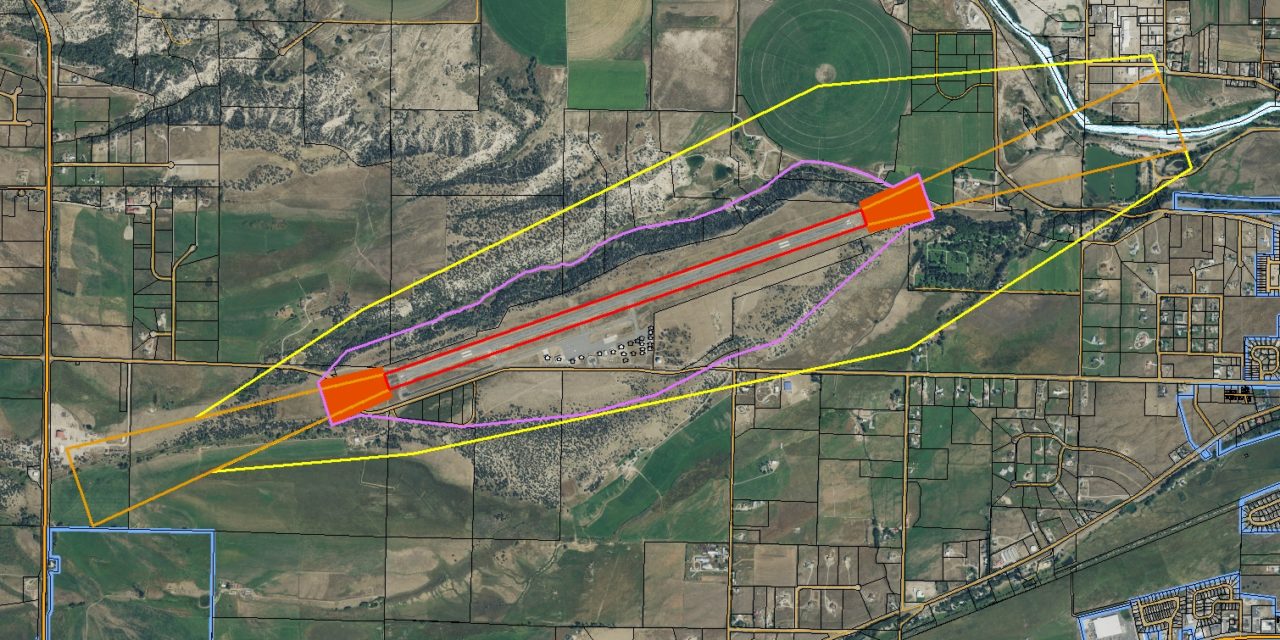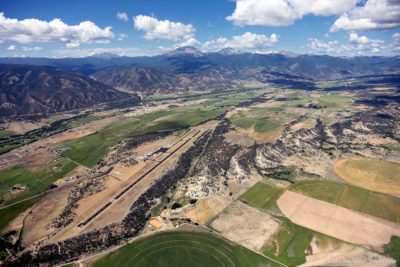It took more than a year to achieve, dozens of meetings and seven continuations on their agenda, but as of Tuesday, Aug. 10, the Chaffee Board of County Commissioners (BoCC) session unanimously approved a new Salida Airport Harriet Alexander Field Overlay District. The overlay area meets the requirements of the Federal Aviation Administration (FAA) limiting development in key areas of the zone around the airport while improving public safety.
“The Airport is an essential part of the Chaffee County transportation system,” said Airport Manager Zech Papp. “We’re trying to come up with the best middle ground to protect the airport … and still give the landowners the best use of their land. That’s how we came to one house on two acres to the south and north, and one house per five acres to the east and west [approach areas].”
The text amendment to the county’s Land Use Code (LUC) was approved by the Airport Advisory Board prior to being presented to the BoCC. It removes existing Section 7. Section 7.7.2 Salida Airport Overland District and replaces it with proposed new Page 1 of 268. Text is available at:
Airports come with noise, light, and public safety issues. The overlay text amendment limits density in the airport overlay district to one residence per five acres in the runway approach areas, and one residence per two acres on the north and south. Staff confirmed five acres is standard density for airport overlay areas. A footnote has been added to the LUC, stating that existing residences within the overlay “shall be treated as nonconforming uses”. If these areas are platted, they must now include an airport proximity note. Auxiliary Dwelling Units (ADUs) will not be permitted in the overlay area, and permanent and private gathering venues will require a major impact review.
The airport is zoned industrial, and any new uses within the zone area would need to meet FAA requirements. The LUC text amendment does include an exemption for private events and memorial services in the airport protection zone.
The move follows the Aug. 2020 adoption of the county’s new comprehensive master plan but precedes the county’s work to revise the rest of the LUC to align it with the comp plan. That prompted an airport-focused text amendment to the LUC, which was drafted by Charlie McDermott.
The approval process became a marathon, with staff meeting with the Airport Advisory Board, the text amendment going to the Planning Commission, back to the Airport Advisory Board, more tweaks, review by the FAA, back to the Planning Commission, and a public hearing. On June 23 staff met with the Airport Advisory Board to review it, then the Planning Commission blessed it before the BoCC session.
The extensive discussion revolved around two issues:
- The fairness of allowing property owners to develop their properties to the fullest extent.
- The need to comply with FAA overlay requirements so federal airport funding is not put in jeopardy and public safety is emphasized.
“The FAA has only seen this once, but we got concurrence that one unit per five acres is a safer approach,” said Planning Manager Jon Roorda about the text amendment. “They are more comfortable with that, but in some cases have allowed one residential unit per two acres.”
Commissioner Rusty Granzella noted that he had been concerned about a singular 5 acres minimum density all around the airport, “but if it can be averaged, (it’s in the LUC) I’m good to go with the motion.”
“So a proposed path forward for someone who wants to do some sort of residential use within the airport approach surface … it comes down to the facts of the specific application,” said BoCC Chair Greg Felt, who offered examples of higher buildings, or higher residential density. “Is this the best case, that the BoCC would have this ability [to decide], or would there be FAA review?
During public comment, resident Dave Brown who lives at 8220 CR 160 on an existing 2.6-acre parcel, asked for clarity regarding the use table developed by staff, and added: “Even the variances are a new encumbrance on land … by putting in variances, you are changing the perceived value of the land.” His property couldn’t be subdivided unless he opted to connect to city sewer and water.
The FAA rules cover air space, not land use. While the area east of the airport bluff does drop off, it doesn’t matter what the terrain is, the approach area is defined by space; the FAA measures the overlay approach area in two dimensions, not three.
“The FAA’s primary concern is the height restrictions – they want to make sure something isn’t constructed that would obstruct the approach surface…. the density is a local condition,” said McDermott. “They don’t regulate or control, but they encourage less density in the approach surface … they want local municipalities to be aware of what they are approving. When it comes to height, this is where the FAA would step in and make a determination that that would be a hazard… as to the height, it depends where you are on the property, and where you are on the surface (it has slopes).”
Airport Manager Zech Papp explained the areas of the overlay map which include the runway approach areas (orange), an airport protection area (purple), and transitional surface (yellow), which are critical, and why the public needs to be made aware of these zones.
“I have emails from 2018, a gentleman looking at buying property, he asked about the traffic pattern, I showed him a full graphic of the flight patterns, and he proceeded to buy the property. Over the past two years, I’ve had two dozen letters from him complaining about noise,” said Papp. “Why we started this was to protect the airport. Setting the airport protection area, and using the terrain, we’ve been able to allow residential on the areas north and south of the runway.
“It’s kind of a cone [shape] said Commissioner Keith Baker. “I will say that somewhere, there needs to be some sort of disclaimer about proximity and encroachment … I have little understanding or mercy for those who build next to an airport, then complain about noise.”
Asst. County Attorney Daniel Tom noted that county staff will do communications to property owners, notifying them that they are within the overlay, and their property might be impacted. He noted that grant assurances are required to receive FAA grants, providing an example: “Item #14, states – you will ensure compatible land use, restricted uses immediate to the airport, and allow operations compatible with airport operations.”
The federal requirements for airport overlays were discussed at length, with Felt asking and receiving confirmation that airport federal financial support is contingent upon the adoption of an airport overlay district, and failure to do so would result in consequences.
“The airport sponsor accepts assurances, to get grants; one of those says that you as the sponsor will ensure protection around the airport area and will manage development, so you don’t jeopardize the funding for the airport and grants for the future,” said Papp. He added the FAA notes the local process to protect an airport from development and keep it industrial. “It was time for us to take this step – it shows the FAA that we’ve done our due diligence here.”
“This [airport] issue has been there as long as the airport has,” said Roorda.
“These are civilian surfaces, but all airports in this country have these surfaces applied to them,” said McDermott. “These overlay plans are not new, they’ve been around since the 1960s.”









The Longhorn development should never have been approved. During its application process a plane crashed there, right where they are now building houses. My husband and I brought it to the attention of our county commissioners on several occasions at the weekly meetings. We had submitted a neighborhood petition as well, and were rudely disregarded by commissioners as “internet trolls”.
If another plane crashes there on top of a newly built house, I’ll be more than happy to talk about my experience being disregarded by our local leaders when we raised the serious concern.
The oversight of our county commissioners and planning commission was grossly negligent in this case. They just wanted to approve it and move on with their lives.
My husband is a pilot in training at the airport so don’t even think about calling me a NIMBY.